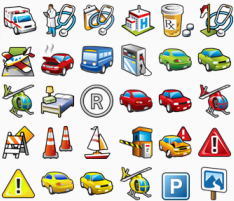Thinking of putting emoji on a map? Please don't
Whatever you call them: pictograms, pictorial markers and mimetic markers have always been hugely important in cartography. Well designed graphics that are used to represent a point of interest are fundamental to topographic mapping in particular but have become vital for web maps that show points of interest across a basemap. They should be clear, unambiguous and allow us to efficiently communicate the feature with simple graphic clarity. They should work in harmony with the rest of the map and subtlety often leads to a well balanced overall map.
They're not easy to design though. You're often working with a very restricted size, perhaps pixel count and, ordinarily, a single colour. With all those constraints it's often difficult to imbue symbols with the meaning required if the intent is to support a map reader's ability to understand the feature without constant recourse to the map legend. This reason alone is why it's more common to use pre-defined symbols delivered as part of your software or available online. There are perfectly good repositories for symbols (e.g.
Symbol Store,
Maki) but what about emoji?
Emoji - the Japanese pictographs which have become standard in electronic messaging. They're increasingly used as shorthand for all sorts of communication.
Their increased use doesn't, however, mean they are well suited to being placed on a map. Take a look at this map, made by Katy DeCorah (click to view the live map as part of Katy's blog).
Katy's
blog entry explains she was interested in exploring a technical challenge, and she succeeded. But what of the outcome? Once the technical challenge had been achieved we still need to consider whether it's useful in a cartographic sense and in this case I'd suggest it isn't though Katy did at least use a limited set of POIs and did a good job of picking an emoji that vaguely represents the feature being mapped.
In general terms these sort of symbols create disharmony. The emoji are too detailed, too colourful and too 'cartoony'. They inevitably clash with the background map and where they begin to coalesce (as they will in a multi-scale environment) they become impossible to decipher. Their style doesn't suit most cartographic work unless you have a very specific mapping project...perhaps a large scale children's atlas. They simply don't look good on a map. For balance...there are other cartoony symbols that I'd also vehemently discourage in cartographic terms. Such as:

One of the tenets of the cartographic design philosophy that I was taught was to keep things simple. The KISS principle (Keep It Simple Stupid) holds true for 99% of cartographic tasks. The best advice any budding cartographer can heed is to learn how to be comfortable omitting detail in terms of the overall map and also the individual elements. Creating clean, simple lines leads to a much more harmonious map and one that is, crucially, much easier to disantangle and read. Symbol design goes a long way to creating that harmony. Just because a set of symbols is technically capable of being put on a map doesn't mean they should be.
Slopping emoji (or other 3D style, multi-coloured, shaded pictorial symbols) all over your map just doesn't work. Use them in your social messaging where a single emoji is often added as an exclamation or to characterise an emotion. Please don't use them en masse on a map...it hurts the eyes and as Kirsten Dunst might say, it's just a piece of poo (ht Craig Williams).







